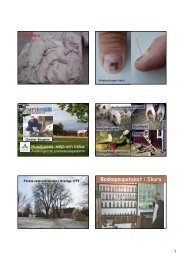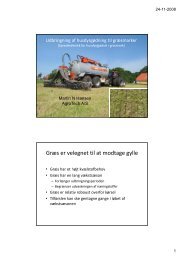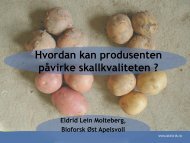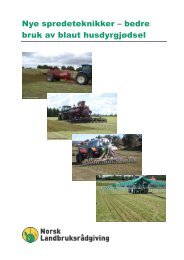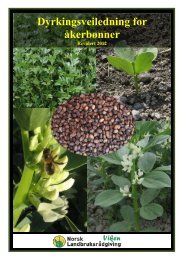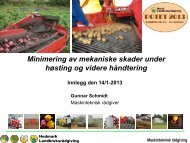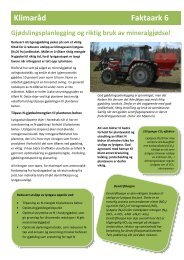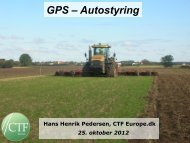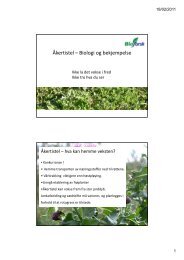Create successful ePaper yourself
Turn your PDF publications into a flip-book with our unique Google optimized e-Paper software.
Bioforsk Rapport<br />
Bioforsk Report<br />
Vol. 5 Nr. 151 2010<br />
The carrot psyllid, <strong>Trioza</strong> <strong>apicalis</strong> -<br />
biology and control<br />
Gulrotsuger, <strong>Trioza</strong> apiclis - biologi og<br />
bekjempelse<br />
Richard Meadow<br />
Bioforsk Plantehelse<br />
Forfatter, Bioforsk rapport nr. Side 1
Tittel/Title:<br />
Hovedkontor/Head office<br />
Frederik A. Dahls vei 20<br />
N-1432 Ås<br />
Tel.: (+47) 40 60 41 00<br />
post@bioforsk.no<br />
Carrot psyllid, <strong>Trioza</strong> <strong>apicalis</strong> - biology and control<br />
Forfatter(e)/Author(s):<br />
Richard Meadow<br />
Bioforsk Senter<br />
Bioforsk Division<br />
Adresse<br />
Postnummer og poststed<br />
Tel.: (+47) 40 60 41 00<br />
fornavn.etternavn@bioforsk.no<br />
Dato/Date: Tilgjengelighet/Availability: Prosjekt nr./Project No.: Saksnr./Archive No.:<br />
01.11.2010 Åpen 1110406 Arkivnr<br />
Rapport nr./Report No.: ISBN -13-nr./ISBN-no: Antall sider/Number of<br />
pages:<br />
5(151)/2010 978-82-17-00707-4 Sider Vedlegg<br />
Oppdragsgiver/Employer:<br />
GA-FA Vestfold<br />
www.gafa.no<br />
Kontaktperson/Contact person:<br />
Lars-Arne Høgetveit<br />
lars-arne.hogetveit@lr.no<br />
Stikkord/Keywords: Fagområde/Field of work:<br />
Gulrotsuger, gulrot, bekjempelses strategier,<br />
feller, alternative metoder<br />
carrot psyllid, carrot, IPM, traps, alternative<br />
control<br />
Sammendrag:<br />
Plantevern<br />
Plant protection<br />
Antall vedlegg/Number<br />
of appendices:<br />
Denne rapporten er en del av et forstudie som har som mål å finne frem til midler og metoder for<br />
bekjempelse av gulrotsuger. Gulrotsuger er en alvorlig skadegjører der den slår til. Men utbredelsen<br />
som viktig skadedyr er begrenset til Norge, Sverige og Finland. Den er også kjent som skadedyr i<br />
noen få land lengre sør, som Sveits. Av den grunn har det vært få vitenskapelige undersøkelser og<br />
det er lite som er kjent om artens biologi og adferd. Dette gjør det vanskelig å lage til bekjempelses<br />
strategier som kan lykkes. Av de få studier som er gjort har noen gått grundig til verks, bl.a. Rygg i<br />
1977. Rapporten gir en oversikt over det som er kjent om gulrotsugeren som kan bygges på med<br />
videre forskning til å komme nærmere en vellykket bekjempelse.<br />
Summary:<br />
This report is part of a preliminary study with the goal of finding control measures and methods to<br />
manage the carrot psyllid. The psyllid is serious pest in the areas it attacks. But its distribution as<br />
an economic pest is limited to Norway, Sweden and Finland. It is also recognized as an occasional<br />
pest in some parts of Central Europe, such as Switzerland. For this reason, there have been very few<br />
scientific studies on this species and little is known about its biology and behavior. This causes<br />
difficulty in designing successful management strategies. Of the few studies that have been done,<br />
some have been very thorough as was the study by Rygg in 1977. The report gives an overview of<br />
most of what is known about the carrot psyllid that can be used as a basis for further research<br />
toward the goal of successful management of this pest.<br />
Land/Country:<br />
Fylke/County:<br />
Kommune/Municipality:<br />
Sted/Lokalitet:<br />
Norge<br />
Akershus<br />
Ås<br />
Ås
This report was commissioned by the Norwegian Agricultural Extension Service office GA-<br />
FA Vestfold and is financed by GA-FA, Fylkesmannen i Vestfold and Gartnerhallen AL. The<br />
background for the commission was the extreme difficulty in controlling the insect pest<br />
<strong>Trioza</strong> <strong>apicalis</strong>, the carrot psyllid or carrot sucker. As a result of ineffective control, the<br />
carrot psyllid causes damage and losses amounting to millions of kroner each year in the<br />
regions of attack.<br />
Distribution, Biology and Life-cycle<br />
In Norway, the regions with reported attack of the carrot psyllid are southeastern and<br />
eastern Norway from Aust-Agder to Hedmark as well as some areas in Nord-Trøndelag. This<br />
distribution does not appear very different from the assumed distribution reported by Rygg<br />
in 1977.<br />
In addition to Norway, the carrot psyllid has long been the cause of damage of economic<br />
importance annually in parts of Sweden and Finland (Nissinen et al. 2007; Nehlin et al.<br />
1994). It is also known as an occaisional pest in central Europe, including Switzerland<br />
(Láska 1974; Burckhardt & Freuler 2000). Because of its relatively limited importance<br />
outside the Nordic countries, the carrot psyllid has been the subject of very little study in<br />
the scientific community. This report collects the current knowledge of the carrot psyllid<br />
in relation to controlling the pest and limiting the damage it causes to the crop, with the<br />
aim of providing a basis for further studies to help alleviate this pest problem.<br />
The carrot psyllid has one generation per year. It tolerates cold climates and is unharmed<br />
by winter temperatures of -18°C (Rygg 1977) and possibly as cold as -30°C (A. Nissinen<br />
pers. com.). It overwinters in the adult stage in coniferous trees, preferably Norway spruce<br />
(Láska 1974, Rygg 1977). This preference was confirmed in a recent study in Sweden where<br />
only a few individuals were found on pine, yew, thuja or other conifers, while the greatest<br />
proportion (over 80%) were in Norway spruce (Kristoffersen & Anderbrant 2007). In the<br />
same study, carrot psyllids were found as far as 1 km from carrot fields. The maximum<br />
distance that the carrot psyllid can fly is not known.<br />
The adult carrot psyllids (fig. 1) leave their winter host in late spring, usually at the time<br />
when the main carrot crop is emerging. Observations in recent years in southern<br />
Lågendalen in Norway, an area with high populations, indicate that immigration began the<br />
last week in May (L.-A. Høgetveit pers. com.). It is currently unknown which cues initiate<br />
the carrot psyllid's migration from its winter host to its summer host. It is likely that it is a<br />
combination of daylength and the quality of the winter host as a nutritional source, as is<br />
the case for migratory aphids. Immigration into carrots often occurs at roughly the same<br />
time as emergence of the carrots from the soil. Rygg (1977) found that there was a higher<br />
rate of flight on days with higher temperature and more hours of sunshine. Both males and<br />
females are found in carrot fields and the assumption is that carrot psyllids mate on<br />
carrots (Kristoffersen & Anderbrant 2007).<br />
Meadow. Bioforsk Rapport vol. 5 nr. 151 2010<br />
2
Fig. 1. Adult carrot psyllid. Photo: Bioforsk<br />
The carrot psyllid also has a strong preference concerning its summer host. Studies have<br />
shown that it chose carrot over other host plants (Rygg 1977; Nehlin et al. 1996). Rygg<br />
also found that the carrot psyllid could not complete its development on other hosts he<br />
investigated. In other studies, where the females were not given a choice of host plants,<br />
they layed eggs on several species related to carrot and the larvae were able to develop on<br />
most of these (Valterová et al. 1997).<br />
When the adults have settled on the carrot plants they begin feeding. They feed by<br />
inserting a stylet into the plant tissue (Hodkinson 1974) and suck nutrients from the<br />
phloem. Feeding by carrot psyllid causes curling of the youngest leaves (fig. 2), not<br />
necessarily directly at the feeding site. This is assumed to be the result of a toxin that is<br />
transported systemically in the plant causing other symptoms, including wilting and death<br />
of the plants (Markkula & Laurema 1971). The toxin is unknown, but recent studies have<br />
shown an association between the carrot psyllid and the plant pathogenic bacterium<br />
Candidatus Liberibacter solanacearum (Munyaneza et al. 2010). In a Norwegian study, a<br />
trained test panel conducted sensory tests of carrots with different levels of carrot psyllid<br />
damage (Seljåsen et al. 2006). They found that plants with heavy attack early in the<br />
growth period yielded carrots that had negative taste characteristics, including bitterness<br />
and astringency, and that the carrots were tough and lacking crispness.<br />
Meadow. Bioforsk Rapport vol. 5 nr. 151 2010<br />
3
Fig. 2. Leaf curling caused by the carrot psyllid. The leaflets at the top are mostly unaffected.<br />
Photo: Bioforsk<br />
The females place the eggs in the leaf tissue, protruding from the edges of the leaves<br />
(fig.3). The nymphs continue the feeding process through 5 stages which last through most<br />
of the summer. The new generation of adults feeds for a period on the carrots before<br />
migrating to the winter host.<br />
The carrot psyllid is very difficult to control using currently registered insecticides.<br />
Growers in Norway have reported poor efficacy when using pyrethroid insecticides against<br />
the pest. Although DNA tests have not been able to confirm genetically based resistance<br />
(Nordhus et al., 2006), the poor effect seems to indicate that the carrot psyllid has<br />
developed resistance against this group of insecticides. This is not unlikely, as evidenced<br />
by the development of insecticide resistance in the carrot psyllid's close relative, the pear<br />
psyllid (Psylla pyricola) (Burts 1989).<br />
Meadow. Bioforsk Rapport vol. 5 nr. 151 2010<br />
4
Fig. 3. Carrot psyllid eggs in leaf and petiole. Photo: Lund University<br />
Living or Non-living Mulch<br />
Based on reports from the 1930s that sawdust among the plants reduced attack by carrot<br />
psyllid (Apsits 1931), studies were conducted in Sweden using different amounts and<br />
application intervals of sawdust. The results confirmed the earlier reports, with a great<br />
reduction in egg-laying and damage to the plants in all of the treatments with sawdust<br />
(Rämert 1993). It appears that the monoterpenes in sawdust from spruce or pine has a<br />
repellent and/or confusing effect. Both fresh sawdust and sawdust treated with turpentine<br />
or monoterpenes greatly reduced damage to carrots from the carrot psyllid (Nehlin et al.<br />
1994). In a study in Norway in the mid-1990s, carrots were grown either by conventional<br />
agronomic practice or in an intercrop or with a mulch of either sawdust or plant material.<br />
There was also a treatment combining an intercrop between beds and a sawdust mulch in<br />
the beds (fig.4). The results showed a significant reduction in the number of plants with<br />
carrot psyllid eggs in all of the treatments with mulch or intercrop (fig. 5). The greatest<br />
reduction was in the treatment with intercrop (vetch) between the beds and sawdust in<br />
the beds (Aas 2000; Brandsæter et al. 1999).<br />
Meadow. Bioforsk Rapport vol. 5 nr. 151 2010<br />
5
Fig. 4. Research plots to compare the attack of carrot psyllid on carrots surrounded by bare soil,<br />
intercrop, plant mulch, sawdust mulch or a combination. Photo: Bioforsk<br />
Fig. 5. The percentage of plants that had carrot psyllid eggs when grown in bare soil or surrounded<br />
by an intercrop of hairy vetch or with mulch. (Source: Aas 2000)<br />
Meadow. Bioforsk Rapport vol. 5 nr. 151 2010<br />
6
Crop Covers<br />
The most effective and most commonly used non-chemical method to control carrot psyllid<br />
and other insect pests of carrot is to cover the crop with insect net or other covers.<br />
Because of the psyllid's small size the netting must have a fine mesh. If the crop is covered<br />
from emergence until the main flight period is done, the carrots should be well protected<br />
from attack. When applying the netting at emergence it is important that the carrots are<br />
sown in depressions of at least 5 cm so the newly emerged plants are not physically<br />
damaged by contact with the net. One problem with this method is the extra labor and<br />
exposure to attack when removing the covers to allow for mechanical weed control<br />
(herbicides can be applied through the netting). Another problem is the change in<br />
microclimate, with both higher humidity and higher temperature. The higher humidity<br />
encourages plant diseases. The higher temperatures (as high as 64° C has been recorded)<br />
cause physiological disorders and negatively affect the quality of the crop.<br />
Exclusion Fences<br />
Fences made of insect netting have been successful in keeping some insect pests out of<br />
vegetable fields. This method was developed especially for low-flying insects such as<br />
cabbage and turnip root flies (Delia spp.)(Meadow & Johansen 2005). Kristoffersen and<br />
Anderbrant (2007) found adult carrot psyllids up to a height of 4 meters above the ground<br />
in spruce trees. In Rygg's studies (1977), there were only small differences between traps 8<br />
cm or 70 cm above the ground in numbers of adult carrot psyllids migrating into the field.<br />
Both of these studies tend to negate the probability of fences being effective to keep<br />
carrot psyllids out of carrot fields. A netting impregnated with insecticide, currently in use<br />
worldwide for protection from and control of mosquitoes, has been developed to protect<br />
vegetable crops from insect pests (fig. 6). Produced by Vestergaard-Fransen under the<br />
tradename Fence ® , the netting is intended to both exclude certain insect pests and<br />
through its attractive color and insecticidal effect, it reduces the pest population by way<br />
of "trap and kill". This type of fence might be a tool in an integrated strategy against the<br />
carrot psyllid.<br />
Meadow. Bioforsk Rapport vol. 5 nr. 151 2010<br />
7
Fig. 6. Exclusion fence with attractive color and impregnated with insecticide. Photo: Bioforsk<br />
Monitoring<br />
Monitoring is an important tool to give the grower information on the time of attack. In the<br />
case of the carrot psyllid it is the adult migration from the winter host to the summer host<br />
that is crucial. If the grower has an insecticide to use, it should be applied in time to<br />
control the adults before they feed on the carrot plants. By the same token, if the grower<br />
is using insect net or other covers it is important to cover the plants before invasion and<br />
also to know when it is safe to remove the covers. The carrot psyllid is currently monitored<br />
using the same yellow sticky-traps (fig. 7) as are used for carrot fly (Psila rosae). No<br />
studies have been done to test the optimal color or optimal placement of these traps. A<br />
study in Finland where the crop was exposed to carrot psyllid attack at different times in<br />
the flight period, to give different attack levels, concluded that one carrot psyllid adult<br />
per trap (5 traps per hectare) was correlated with economic damage (Tiilikkala et al.<br />
1996). Researchers in Switzerland currently use the yellow sticky-traps in an extension<br />
strategy to indicate when the first adult carrot psyllids come into the field. The growers<br />
are informed at the start of the attack and follow up by observing 20 plants at 10<br />
reference points in the field for curling damage (Fischer & Terrettaz 2002; S. Fischer pers.<br />
comm.). These observations are compared to treatment thresholds to determine whether<br />
or not to apply insecticide.<br />
Meadow. Bioforsk Rapport vol. 5 nr. 151 2010<br />
8
Fig. 7. Yellow sticky trap for monitoring flight activity of the carrot psyllid. The vials near<br />
the top of the post are experimental dispensers for attractants. Photo: GA-FA Vestfold<br />
To inrease monitoring efficiency, research has been done to identify the plant components<br />
that are attractive to the carrot psyllid. Swedish studies found two components that were<br />
present in high amounts in attractive plant species, sabinene and alpha-pinene (Nehlin et<br />
al 1996). They also found that species with high amounts of another component, limonene,<br />
were very unattractive to adults of the carrot psyllid. The attractive components have<br />
since been studied to enhance trapping, but so far without success. The unattractive<br />
components have been tested for repellent effect which appears to reduce attack when<br />
applied in high amounts (Nehlin et al. 1994). It is likely that the repellent effect is due to<br />
the predominance of these compounds in the winter host, spruce. Since the adults have<br />
received cues to leave the spruce and seek out carrot, it is reasonable to conclude that<br />
they are repelled by the odor of the winter host.<br />
Future Prospects<br />
Because the carrot psyllid is a pest of a small crop there is little (or no) investment by<br />
international pesticide companies to find insecticides for this pest, neither chemical<br />
compounds nor biological control agents. There are few closely related pest species on<br />
closely related crops, so the possibilities for off-label registration of insecticides against<br />
carrot psyllid are also very limited. Since damage is initiated by attack of overwintered<br />
adults on small plants, an insecticidal control has to be quick acting. The most likely<br />
candidates should have a contact effect and/or be systemic in the plant, since the psyllid<br />
feeds from the plant phloem. Of the synthetic insecticides, ones with new chemistries will<br />
help avoid problems with resistance. Spirotetramat (trade name Movento) is one such<br />
insecticide that has a good effect against sucking insects, including psyllids (Brück et al.<br />
2009).<br />
Meadow. Bioforsk Rapport vol. 5 nr. 151 2010<br />
9
Biological control agents will probably have most effect against the nymphs of carrot<br />
psyllid. Their biggest contribution in a management strategi will likely be to reduce<br />
populations in a region to improve the situation for the following year. A strain of the<br />
insect pathogenic fungus Paecilomyces (=Isaria) fumosorosea has been shown to have a<br />
good effect against the Asian citrus psyllid Diaphorina citri, a major pest of citrus that has<br />
threatened the Florida citrus industry (Avery et al. 2009; Hoy et al. 2010). P. fumosorosea<br />
non-specific and is also native to Norway, so this fungus could be a candidate for further<br />
investigation as a tool in an integrated management program.<br />
As this report has shown, much research remains to be done to have a better<br />
understanding of the biology and behavior of the carrot psyllid in order to develop an<br />
effective management strategy. In terms of more basic research, we need to investigate<br />
the response of the carrot psyllid to plant odors and pheromones. Finding the most<br />
attractive odors will provide a tool for monitoring, trap-and-kill and push-pull strategies.<br />
Further studies on repellant odors such as the monoterpenes, will help us to keep the<br />
carrot psyllid from finding the carrot host plants and can also be utilized in push-pull<br />
strategies.<br />
Studies on the carrot psyllid's migration behavior will shed light on the alternative hosts<br />
that it utilizes after leaving the winter host (spruce) until it arrives on the summer host<br />
(carrot). This knowledge will provide the opportunity to monitor the pest before it begins<br />
feeding on the crop and give the growers time to protect the crop.<br />
Applied research also needs to be done. Methods need to be developed for protecting the<br />
crop from attack, including directly reducing the population of the carrot psyllid. New<br />
insecticides need to be tested for their effect on controlling this pest. Biological control<br />
agents should be included in such tests. Ways to physically prevent the psyllid from<br />
reaching the plants, such as exclusion fences, should be further studied. Dependable<br />
methods, such as crop covers of insect netting need to be optimized to give maximum<br />
protection without undue negative effects on crop quality.<br />
References cited<br />
Aas, T. 2000. Soil cover of living and dead plant material against the carrot psyllid. M.sc.<br />
Thesis. The Agricultural University of Norway 69 pp.<br />
Apsits, J. 1931. Emploi du papier-carton et de la sciure de bois comme couverture du sol<br />
pour remplacer les binages. Annales Agronomiques 1: 467-494.<br />
Avery, P.B., Hunter, W.B., Hall, D.G., Jackson, M.A., Powell, C.A. & Rogers, M.E. 2009.<br />
Diaphora citri (Hemiptera: Psyllidae) infection and dissemination of the<br />
entomopathogenic fungus Isaria fumosorosea (Hypocreales: Cordyciptaceae) under<br />
laboratory conditions. Florida Entomologist 92: 608-618.<br />
Brandsæter, L. O., Meadow, R., Ugland, A. & Aas, T. 1999. Jorddekking i gulrot. Grønn<br />
forskning 4: 109-112.<br />
Brück, E., Elbert, A., Fischer, R., Krueger, S., Kühnhold, J., Klueken, A.M., Nauen, R.,<br />
Niebes, J.-F., Reckmann, U., Schnorbach, H.-J., Steffens, R. & van Waetermuelen, X.<br />
2009. Movento ® , an innovative ambimobile insecticide for sucking insect pest control<br />
in agriculture: Biological profile and field performance. Crop Protection 28: 838-844.<br />
Burkhardt, D. & Freuler, J. 2000. Jumping plant-lice (Hemiptera: Psylloidea) from sticky<br />
traps in carrot field in Valais, Switzerland. Mitteilungen der Schweizerischen<br />
Entomologischen Gesellschaft 73: 191-209.<br />
Burts, E.C. 1989. Pyrethroid resistance in pear psylla, Psylla pyricola Förster (Homoptera:<br />
Psyllidae), and synergism of pyrethroids with piperonyl butoxide. The Canadian<br />
Entomologist 121: 219-223.<br />
Meadow. Bioforsk Rapport vol. 5 nr. 151 2010<br />
10
Fischer, S. & Terrettaz, C. 2003. A strategy for the control of carrot psylla (<strong>Trioza</strong> <strong>apicalis</strong><br />
Förster) in Switzerland. IOBC/WRPS Bulletin 26: 331-338.<br />
Hodkinson, I.D. 1974. The biology of the Psylloidea (Homoptera): a review. Bulletin of<br />
Entomological Research 64: 325-339.<br />
Hoy, M.A., Singh, R. & Rogers, M.E. 2010. Evaluation of a novel isolate of Isaria<br />
fumoserosea for control of the Asian citrus psyllid, Diaphorina citri (Homoptera:<br />
Psyllidae). Florida Entomologist 93: 24-32.<br />
Kristoffersen, L. & Anderbrant, O. 2007. Carrot psyllid (<strong>Trioza</strong> <strong>apicalis</strong>) winter habitats -<br />
insights in shelter plant preference and migratory capacity. Journal of Applied<br />
Entomology 131(3): 174-178.<br />
Láska, P. 1974. Studie über den Möhrenblattfloh (<strong>Trioza</strong> <strong>apicalis</strong> Först)(Triozidae,<br />
Homoptera). Acta Sc. Nat. Brno 8(1): 1-44.<br />
Markkula, M. and S. Laurema 1971. Phytotoxaemia caused by <strong>Trioza</strong> <strong>apicalis</strong> Forst. (Hom.,<br />
Triozidae) on carrot. Annales Agriculturae Fenniae 10: 181-184.<br />
Meadow, R. & Johansen, T.J. 2005. Exclusion fences against Brassica root flies (Delia<br />
radicum and D. floralis). IOBC/WPRS Bulletin 28: 39-43.<br />
Munyaneza, J.E., Fisher, T., Sengoda, V.G., Garczynski, S.F., Nissinen, A. & Lemmetty, A.<br />
2010. Association of "Candidatus Liberibacter solanacearum" with the psyllid, <strong>Trioza</strong><br />
<strong>apicalis</strong> (Hemiptera: Triozidae) in Europe. Journal of Economic Entomology 103(4):<br />
1060-1070.<br />
Nehlin, G., Valterová, I. & Borg-Karlson, A.-K. 1994. Use of conifer volatiles to reduce<br />
injury caused by carrot psyllid, <strong>Trioza</strong> <strong>apicalis</strong>, Förster (Homoptera, Psylloidea).<br />
Journal of Chemical Ecology 20: 771-783.<br />
Nehlin, G., Valterová, I. & Borg-Karlson, A.-K. 1996. Monoterpenes released from Apiaceae<br />
and the egg-laying preferences of the carrot psyllid, <strong>Trioza</strong> <strong>apicalis</strong>. Entomologia<br />
Experimentalis et Applicata. 80: 83-86.<br />
Nissinen, A., P. Vanhala, J. K. Holopainen & K. Tiilikkala 2007. Short feeding period of<br />
carrot psyllid (<strong>Trioza</strong> <strong>apicalis</strong>) females at early growth stages of carrot reduces yield<br />
and causes leaf discolouration. Entomologia Experimentalis et Applicata 125(3): 277-<br />
283.<br />
Nordhus, E., Andersen, A., Meadow, R., Trandem, N. & Johansen, N. 2006. Resistens mot<br />
skadedyrmidler stadig mer utbredt. Gartneryrket 4: 23-28.<br />
Rämert, B. 1993. Sawdust can be used for control of the carrot psyllid (<strong>Trioza</strong> <strong>apicalis</strong>).<br />
Vaxtskyddsnotiser 57(2): 34-38.<br />
Rygg, T. 1977. Biological investigations on the carrot psyllid <strong>Trioza</strong> <strong>apicalis</strong> Förster<br />
(Homoptera, Triozidae). Scientific Reports of the Agricultural University of Norway<br />
56(3): 1-19.<br />
Seljåsen, R. Høgetveit, L.A., Tajet, T., Bengtsson, G. & Meadow, R. 2006. Effekt av<br />
gulrotsuger (<strong>Trioza</strong> <strong>apicalis</strong>) på sensorisk kvalitet i gulrot. Bioforsk Fokus 1(3): 90-91.<br />
Tiilikkala, K., Ketola, J. & Taivalmaa, 1996. Monitoring and threshold values for control of<br />
the carrot psyllid. IOBC/WRPS Bulletin 19(11): 18-24.<br />
Valterová, I., Nehlin, G. & Borg-Karlson, A.-K. 1997 Host plant chemistry and preferences<br />
in egg-laying <strong>Trioza</strong> <strong>apicalis</strong> (Hemiptera, Psylloidea). Biochem. Syst. Ecol. 25: 477-<br />
491.<br />
Meadow. Bioforsk Rapport vol. 5 nr. 151 2010<br />
11




